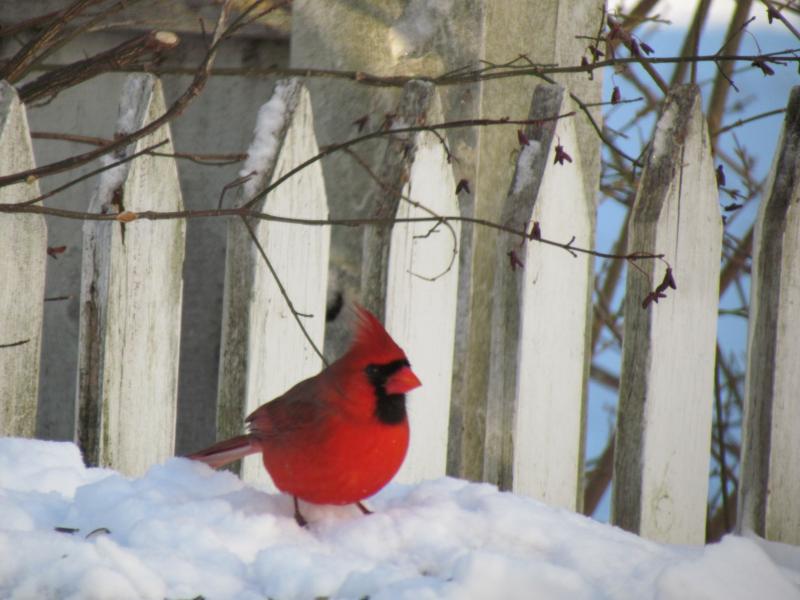Amotz Zahavi and a Cardinal in the Snow
The new blanket of white snow that came with our recent storms gave us, and probably many of you, the gift of views of bright, red male cardinals contrasting against the sea of whiteness. Many a holiday card has been adorned with this same scene that we humans find such a visual pleasure.
But a male cardinal sitting in the snow, though striking to us, is like a ringing dinner bell to any bird-eating hawk, cat, or other creature in the neighborhood. With that perspective, it might seem hard to understand why a male cardinal would be so bright red. That question has arisen since Darwin’s time, and with many other birds and other animals. One of the more famous examples is the male peacock’s massively long, elaborate, and heavy tail. Such a tail must certainly make it harder to get away from a determined predator.
Even the act of singing, as so many male (and some female) birds do in the spring and summer, would make the singer easier for a predator to detect and locate, say nothing of the fact that most male birds tend to sing from exposed perches.
Scientists postulate that the reason one sex—more often males—may have evolved bright colors, showy ornamentation, or elaborate songs and other behaviors, is through what is called sexual selection. So, for example, if female cardinals prefer males that are brighter red than other males, then selection will push the population of male cardinals to be brighter red (within the range of reds that is possible within the cardinal genetic pool, at least).
An ornithologist named Amotz Zahavi proposed, in 1975, another twist to the idea. He suggested that bright colors, long tails, and other traits, even while conferring an advantage in attracting mates, might also be detrimental to survival. In other words, these traits may be what he called a handicap. Zahavi’s idea came to often be known as the Zahavi Handicap Principle and has been the subject of much scientific debate and study. One way that the idea is sometimes formulated is that a particular trait, like the bright red plumage in a male cardinal, could make it harder for a male to survive. So any males that do survive might well be quicker, more agile, stronger, and more clever than those that do not survive. For a female cardinal trying to choose a mate, a surviving red male would be an honest signal of his having “good” genes. If being redder did not have a survival cost, then brighter, redder males might not actually be better; in fact, it could be that brighter, redder males might be more likely to be poor nest helpers or have some other deficiency (from a female’s perspective).
In some bird species, the survival “handicap” of bright plumage is only taken on during a limited season. In many warblers, the males are brightly colored during the spring and summer, and molt into a more female-like plumage in winter. In ducks, males molt into a female-like plumage (called an “eclipse plumage”) in mid-summer, when they also molt their flight feathers and become flightless and very vulnerable to predation for a short period.
Some scientists have argued that we may see some of these kinds of concepts at play in humans. Does having a large, expensive car or truck convey a message to the opposite sex about a person’s wealth and likelihood to be a good mate? And if so, is this in part because we know that having an expensive item comes at an explicit monetary cost?
Who would have thought that a red cardinal in the snow could open up so many questions?
Jeffrey V. Wells, Ph.D., is a Fellow of the Cornell Lab of Ornithology. Dr. Wells is one of the nation's leading bird experts and conservation biologists and author of the “Birder’s Conservation Handbook.” His grandfather, the late John Chase, was a columnist for the Boothbay Register for many years. Allison Childs Wells, formerly of the Cornell Lab of Ornithology, is a senior director at the Natural Resources Council of Maine, a nonprofit membership organization working statewide to protect the nature of Maine. Both are widely published natural history writers and are the authors of the popular book, “Maine’s Favorite Birds” and the newly released “Birds of Aruba, Bonaire, and Curaçao” from Cornell University Press.































